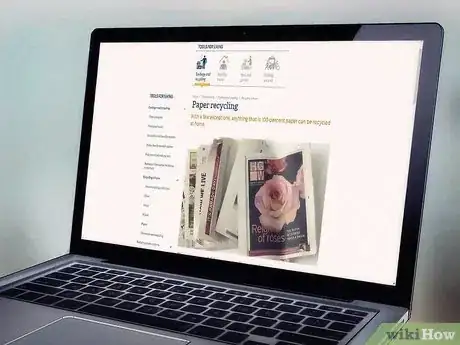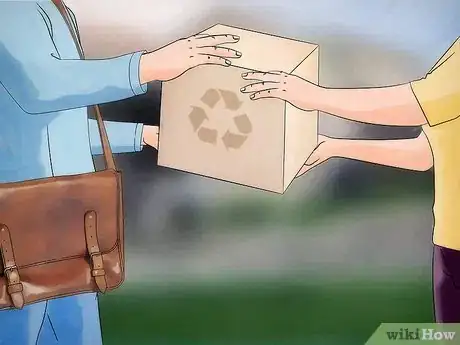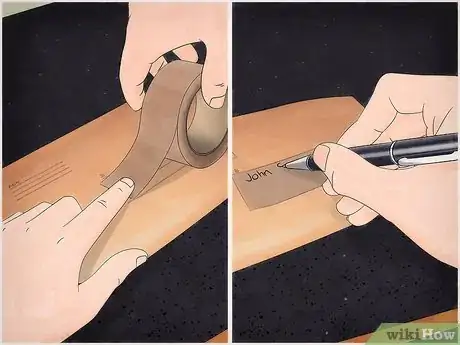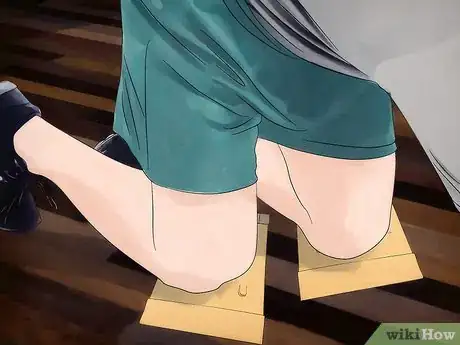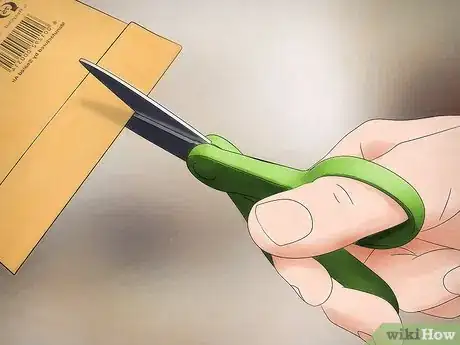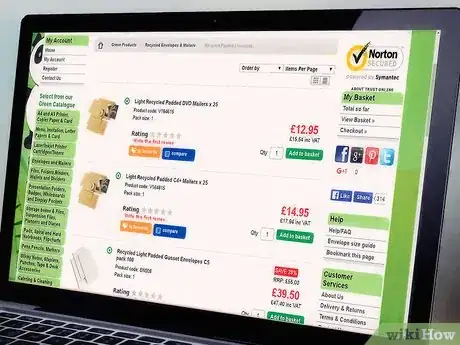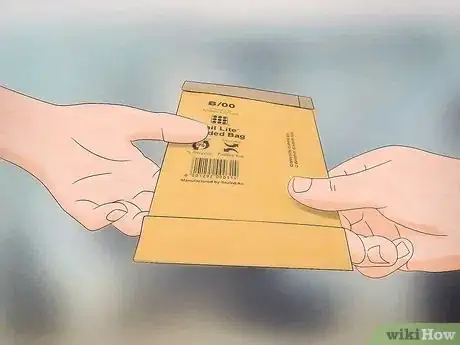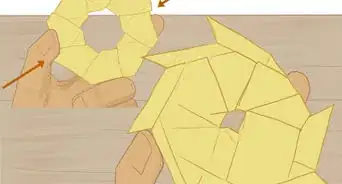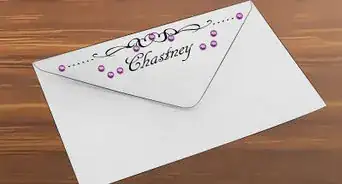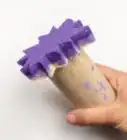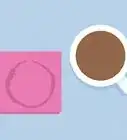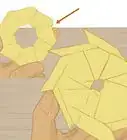This article was co-authored by Kathryn Kellogg. Kathryn Kellogg is the founder of goingzerowaste.com, a lifestyle website dedicated to breaking eco-friendly living down into a simple step-by-step process with lots of positivity and love. She's the author of 101 Ways to Go Zero Waste and spokesperson for plastic-free living for National Geographic.
There are 9 references cited in this article, which can be found at the bottom of the page.
wikiHow marks an article as reader-approved once it receives enough positive feedback. In this case, 90% of readers who voted found the article helpful, earning it our reader-approved status.
This article has been viewed 111,671 times.
Padded envelopes are cushioned mailers that provide extra protection and support during mailing or shipping. The exterior is often made of heavy paper or paperboard, and the padding is bubble wrap, newsprint or another filler material. Depending on the size, padded envelopes can cost around $1 each. They can be tough to recycle, but there are things you can do with the padded envelopes to be more environmentally sound.
Steps
Figuring Out Where to Take the Padded Envelope
-
1See if the envelope provides information about recycling. Many padded envelopes may actually provide information about proper recycling guidelines. Scan the envelope for recycling information. If you find information on the envelope itself, this is probably the easiest way to figure out where to take the envelope for recycling.
-
2Check with your local government. Different communities may have different recycling rules when it comes to padded envelopes, and the rules often hinge on what the envelope's material composition. Check with your local city, village or town hall about the rules in your area.[1] [2]
- Generally speaking, padded envelopes that are entirely constructed of paper are usually recyclable. The envelopes that contain material that looks like dryer lint are recyclable in many communities.
- However, paper envelopes that contain mixed materials, such as paper and plastic (like bubble wrap) may not be recyclable unless you are able to separate the plastic from the paper, and discard them separately (the paper in your bin and the plastic at a special recycling center in your community). In Seattle, for example, padded envelopes are generally non-recyclable. Check with your local government about regulations, especially if you have padded envelopes with bubble wrap inside.
Advertisement -
3Contact the manufacturer. Different padded envelopes will require different recycling approaches. Check with the manufacturer. Some manufacturers' websites offer suggestions for recycling of padded envelopes, and some manufacturers have well developed recycling programs.
- Some communities will not accept certain padded envelopes, such as those heavily coated with plastic film, for recycling at all. They also do not recommend that you compost them. Some manufacturers have set up custom programs that work with local recyclers in your region instead.
- For example, Tyvek industrial packaging contains high-density polyethylene. However, the manufacturer has set up a network of recyclers to take back the items. Contact the manufacturer directly.
- Sometimes plastic coating on envelopes can be mechanically recycled into other products, such as cable protection piping, automotive parts, and blown film.[3]
-
4Check with the post office. The United States Postal Service has a recycling program so strong that it reported recycling 220,000 tons of envelopes, wastepaper, and other materials in one recent year alone. It’s possible the post office will take your padded envelope.[4]
- The post office buys and uses some recycled materials and also provides recyclable mailers for purchase at some locations.
- Many packaging stores (like UPS) may also accept padded envelopes. Check with the local office to find out for sure.
- If your local post office won't accept the materials, the post office may still be able to recommend other recycling locations.
Using the Padded Envelope Again
-
1Reuse the envelope. Instead of throwing away the padded envelope, just use it again! You could easily cross off the address, and send the envelope out again, rather than prematurely tossing it into a garbage can.
- If you don’t want the old address to be visible, cross it off, and then cover it with a shipping label or piece of adhesive paper on which you write the new address. That way you won’t have to throw it away.[5] Use tape to reseal the envelope.[6]
- If you have no reason to reuse the padded envelope immediately, store it in a drawer where you keep things like gift bags that you intend to reuse. There will likely come a time when you need to use it.
- The good thing about padded envelopes is that you can save them literally for years. It will save you money to reuse the padded envelope, anyway, as they are more expensive than normal envelopes.
-
2Offer them to others for use. Many communities have sites where people offer items for free to other people in the community. You can find such sites on social media or other websites most commonly.
- Especially if you have padded envelopes in bulk, rather than trying to throw them away, offer them for free to anyone who needs them. Non-profits, small businesses, or community organizations, especially, might have a use for them.
- You could also offer them up for free to other friends or family via your own social media sites. Neighbors might also have some use for them.
- It’s almost always better to repurpose items than to risk clogging landfills with them. Padded envelopes are pretty durable and can usually withstand several uses. Try selling them on online auction sites if you have a lot of them.
- Give the envelopes to a local business that you want to support. The envelopes actually cost a lot of money if you use a lot of them, so this could help someone out.
-
3Find creative uses for them. Because padded envelopes are pretty strong, people have found creative ways to reuse them. Just because they’re envelopes doesn’t mean they have to be used for mail![7]
- Some people have even used padded envelopes to protect their knees when working on projects such as in the garden. You will prevent your knees from getting dirty or scuffed if you kneel on the envelopes while working.
- Other people use the padded envelopes for storage. Common items stored in padded envelopes include jewelry or Christmas ornaments. Use bubble wrap to protect outside plants from bad weather conditions.
- Bring them to sporting events or anywhere that a child might end up sitting on a hard chair. Use the padded envelope as a makeshift chair pad to prevent sore butts.
-
4Give the envelopes to your older children for art projects. Kids love to draw and color on unique surfaces. Let them use the envelopes for play. Keep them away from small children though, who might get hurt if the stuffing is plastic.
- If you don't know anyone with children, you can donate the envelopes to a school or local art center.
Being Environmentally Sound When Using Envelopes
-
1Buy recycled padded mailers. Although this won’t take care of padded envelopes that other people send you, it’s possibly for you to purchase recycled padded mailers if you need to send padded envelopes to someone else.[8]
- Recycled padded mailers are available for sale online, and they are made out of recycled trash in the first place! Thus, they are more environmentally sound. Padded envelopes that are not made of mixed materials (like paper and bubble wrap) will be easier to discard.
- Such envelopes may be a little more expensive than regular padded envelopes, but you will gain the peace of mind of knowing that you are not causing extra harm to the environment. There are sites on the Internet that sell recycled paper and green office supplies.
- Some padded envelopes are also biodegradable, so you don’t need to worry about throwing them into the trash. Check the back of the envelope to see if it's biodegradable.
-
2Remove the plastic wrap. Some recycling programs in communities require that the plastic wrap be removed from the paper part of the envelope before it can be recycled.[9]
- In this case, you would remove any plastic wrap and take it to a plastic film drop off location in your community, if it has one.
- Throw away any leftover paper into your normal recycling bin, where you would place other paper items, such as regular envelopes or newspapers.
- If the entire envelope is paper and it does not contain any plastic or bubble wrapping, you could put it directly into the recycling bin with other paper items.
EXPERT TIPKathryn Kellogg is the founder of goingzerowaste.com, a lifestyle website dedicated to breaking eco-friendly living down into a simple step-by-step process with lots of positivity and love. She's the author of 101 Ways to Go Zero Waste and spokesperson for plastic-free living for National Geographic.Sustainability Specialist
 Kathryn Kellogg
Kathryn Kellogg
Sustainability SpecialistRecycle the inside and out of the envelope separately. Kathryn Kellogg, the author of 101 Ways to Go Zero Waste, says: "If your envelope is made of both paper and plastic, separate the paper from the plastic, then recycle the paper in your curbside bin and take the plastic to film recycling. You can find film recycling at the front of some grocery stores and big-box stores like Target."
-
3Return the envelope to the original shipper. Sometimes, the person or company that sent you the envelope will be better able to reuse it than you are by sending it to another customer.
- Used booksellers have been known to include postage that would enable their buyers to send the envelope back. Ask the sender if he or she would like you to return the envelope.
Community Q&A
-
QuestionCan I pop the bubble wrap?
 Community AnswerOf course! That's the best part of padded envelopes that come with bubble wrap. It's fun to pop.
Community AnswerOf course! That's the best part of padded envelopes that come with bubble wrap. It's fun to pop. -
QuestionHow can I separate plastic from paper in padded envelope?
 Community AnswerSimply pull it apart, perhaps using a razor blade (carefully) to split the plastic away from the paper. With some padded envelopes, though, you won't be able to separate them.
Community AnswerSimply pull it apart, perhaps using a razor blade (carefully) to split the plastic away from the paper. With some padded envelopes, though, you won't be able to separate them.
References
- ↑ http://www.seattle.gov/util/EnvironmentConservation/MyHome/Recycling/WhatsAcceptedHouse/index.htm
- ↑ http://www.oregonmetro.gov/tools-living/garbage-and-recycling/recycling-home/paper-recycling
- ↑ http://www.dupont.com/products-and-services/packaging-materials-solutions/industrial-packaging/articles/recycling-information.html
- ↑ https://about.usps.com/what-we-are-doing/green/recycle.htm
- ↑ http://earlyretirementextreme.com/envelope-recycling.html
- ↑ http://www.keeptruckeegreen.org/guide/padded-envelopes/
- ↑ http://www.recyclethis.co.uk/20070328/how-can-i-reuse-or-recycle-old-padded-envelopes
- ↑ http://www.ecoenclose.com/category_s/20450.htm
- ↑ http://sfenvironment.org/news/update/tis-the-season-to-recycle
About This Article
If you’re unsure if you can recycle your padded envelope, check the back for a recycling logo, which means you can recycle the item. Generally, you can recycle padded envelopes made entirely of paper, but ones with bubble wrap inside may not be recyclable. Check with your local government regulations too, since these can vary from area to area. If you can’t recycle your padded envelope, you might be able to take it to your local post office. Many post offices have recycling programs for envelopes. Alternatively, save the envelope to mail something in the future. For more tips from our Environmental co-author, including how to find creative uses for your padded envelopes, read on!

